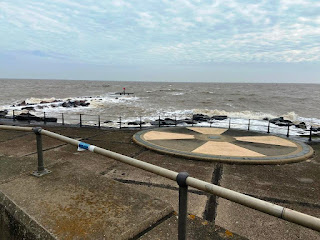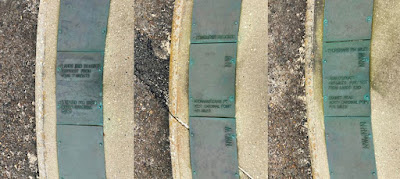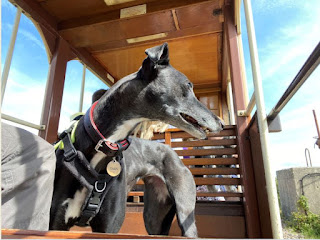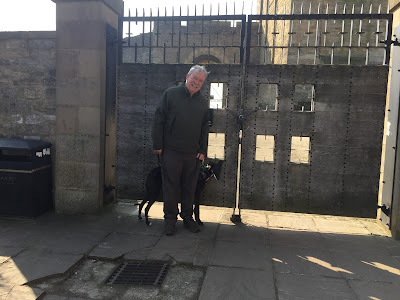We came here for our wedding anniversary. You need to understand a little history first, so bear with us ...
Before we were married, we found a wonderful caravan site on the bank of Loch Naver in the far north of Scotland. It was (and still is) tiny and has very few facilities - no toilet or amenities block, just a tap to get water, somewhere to empty waste and it had a few electric hookups (US call these "shore power"). No TV and there was a payphone one could use. The nearest shops were 18 miles away. It was wonderful! The nearest village is Altnaharra, famous for the Altnaharra Hotel (of which more shortly) which opened in 1820 and quickly became a popular place for anglers to stay while visiting nearby lochs.
Altnaharra has a Met Office weather station, its northerly latitude and inland location mean that in winter it often features in the daily weather extremes for the United Kingdom. It is unusual in that the coldest month of the year is normally December. On 30 December 1995, the UK's lowest recorded temperature −27.2 °C (−17.0 °F) was measured here!
Anyway, back to that hotel ... we used to visit the hotel for tea and occasionally dinner, but after we were married it became a fixed tradition to travel to the caravan site for our anniversary (during the summer half term holiday) and have our anniversary dinner at the hotel. We did that for many years, only missing June 1994 out because Hannah was only just born ... although we did go in August that year with her at 3 months old! We only stopped going every year when we got the caravan at Stanwix Park in 2005.
Then we realised that not only had we not been to Altnaharra for a long time, we could also afford to stay there! So we did and that's what this post is about.
We stayed in a hotel cottage right beside the burn after which the village is named: Allt na h-Eirbhe, Scottish Gaelic meaning Stream at the boundary wall. In the photo left, the hotel is under the trees and the cottage is the white building. Of course we had dinner on our anniversary evening, accompanied by Tara this time. Although we chose from the restaurant menu, we dined in the bar (Tara was not allowed in the restaurant) which was great because the local ghillie held court for most of the evening, telling fabulous stories from the past and present and advising anyone who would listen about the best places to fish. We listened, joined in enough to keep him going, and came away better people. We were even able to swap stories about people we had known from our visits decades previously, that he knew or had known too. It made our evening!
Ghillie or gillie is an ancient Gaelic term for a person who acts as an attendant on a fishing, fly fishing, hunting, or deer stalking expedition, primarily in the Highlands. This position still exists here and in a few other Highland locations. They are no longer manservants or attendants and do not carry Chiefs across rivers as in the distant past; today, they manage the area and guide travellers through it.
We also met one of the senior technicians from the
huge Altnaharra windfarm project (72.6MW) who had come to the hotel for
his dinner too.
Altnaharra was originally called Altnaharrow (Gaelic: allt-na-charra, 'stream of the stone pillar'). Two pillars stands at the north side of the village on the A835, the photo shows one of them. They were erected about 1850 at the instigation of the Duke of Sutherland who felt that there should be signposts at the crossroads for the guidance of travellers unfamiliar with the country.
There is an interesting (if a little unhappy) story about the pillars, which is reproduced at the bottom of this post. Scroll down if you want to read it, but we won't subject everyone to it!
While we were here, we went across to the North East and visited John o'Groats and Dunnet Head as part of the Six Points Tour (click here for more details of that).
Many years ago, in 1955, the UK dipped its toe into nuclear power generation and the Dounreay Nuclear Power Development Establishment was formed primarily to pursue the UK Government policy of developing civil fast breeder reactor (FBR) technology. Three nuclear reactors were built there by the UKAEA, first a materials test reactor, then two fast breeder reactor prototypes. There were also fabrication and reprocessing facilities for the materials test rigs and for fuel for the FBRs. The reactors themselves are now closed down and the cleanup operation continues. There used to be a visitor centre and one could go on a guided tour, but it's pretty much all gone now. The picture (below) show the site as it is now.
Extract from the Scots Magazine June 1987 about the pillars at Altnaharra.
Altnaharra, the small township at the head of Loch Naver in Sutherland has a crossroads with two large stone pillars approximately ten feet high by three in diameter.
They were erected about 1850 at the instigation of the Duke of Sutherland who felt that there should be signposts at the crossroads for the guidance of travellers unfamiliar with the country. A ploughman was sent from Tongue Mains with two carts to collect stones for pillars from the Glencraggach Quarry at Drumholistan on the Caithness / Sutherland border and convey them to Altnaharra the following day. The stones were duly loaded on the carts, and the ploughman set out.
At that time, and for many years afterwards, the crossing of the River Halladale was by chain-ferry, a raft pulled across by winch. The ferryman took one look at the loaded carts and refused the ploughman passage on account of their weight. A considerable diversion had to be made by way of Strath Halladale.
The weather was very wet, and when he arrived at Kinbrace the burns were too full to be forded. His only recourse was to take an even longer way round by the Strath of Kildonan to the coast road, thence by Rogart to Lairg, and on to Altnaharra.
The ploughman would have travelled approximately 30 miles each day, and in bad weather without protective clothing. His journey must have been long and arduous.
Nevertheless, the stones were duly delivered to Altnaharra and the weary ploughman made for home in Tongue, where he died of pneumonia leaving a widow and a two year old son.
In 1939 the War Office ordered that the inscription on the stones be removed in case of an enemy landing. The pillars used to carry the directions:- TO TONGUE: TO DURNESS THRU STRATHMORE, and on the other:- TO GOLSPIE: TO BETTYHILL THRU STRATHNAVER.














.JPG)









.JPG)



